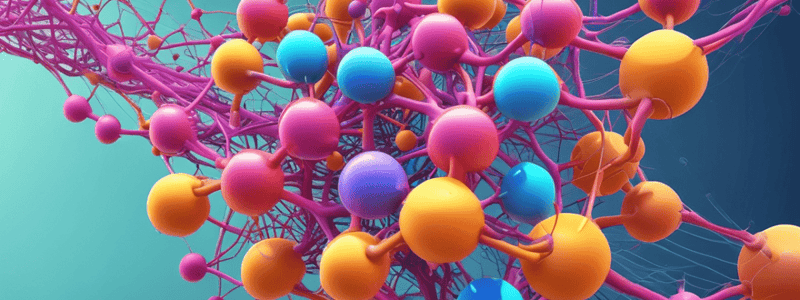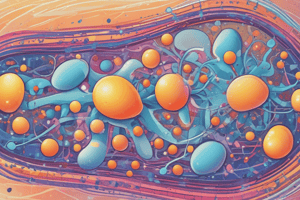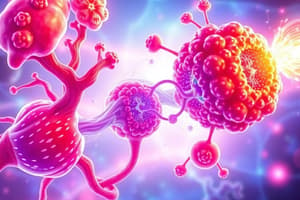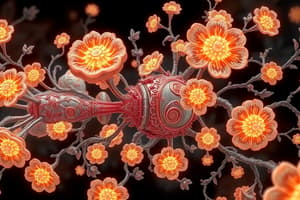Podcast
Questions and Answers
What is the primary function of oxidative phosphorylation?
What is the primary function of oxidative phosphorylation?
- Breaking C-C bonds in glucose
- Synthesizing NADH and FAD2H
- Using energy from oxidation of NADH and FAD2H to synthesize ATP (correct)
- Transferring electrons from ATP to oxygen
What is the energy source used by the electron transport system in oxidative phosphorylation?
What is the energy source used by the electron transport system in oxidative phosphorylation?
- Protons
- ADP
- NADH and FAD2H (correct)
- Glucose
What is the primary function of uncoupling proteins (UCPs) in brown adipose tissue?
What is the primary function of uncoupling proteins (UCPs) in brown adipose tissue?
- To generate heat by dissipating the proton-motive force (correct)
- To increase the production of ATP
- To transport glucose into the mitochondria
- To store fatty acids for later use
In which stage of catabolism does oxidative phosphorylation occur?
In which stage of catabolism does oxidative phosphorylation occur?
What happens by the end of the TCA cycle in relation to carbon atoms?
What happens by the end of the TCA cycle in relation to carbon atoms?
What is the role of NADH and FAD2H in the electron transport chain?
What is the role of NADH and FAD2H in the electron transport chain?
What is the effect of inhibitors of the electron transport chain, such as carbon monoxide and cyanide?
What is the effect of inhibitors of the electron transport chain, such as carbon monoxide and cyanide?
What is the role of electrons in NADH and FAD2H during oxidative phosphorylation?
What is the role of electrons in NADH and FAD2H during oxidative phosphorylation?
How does noradrenaline (norepinephrine) affect the function of brown adipose tissue?
How does noradrenaline (norepinephrine) affect the function of brown adipose tissue?
Which part of the mitochondrion is involved in ATP synthesis during oxidative phosphorylation?
Which part of the mitochondrion is involved in ATP synthesis during oxidative phosphorylation?
What is the consequence of the lack of a proton-motive force due to inhibition of the electron transport chain?
What is the consequence of the lack of a proton-motive force due to inhibition of the electron transport chain?
Which of the following complexes in the electron transport chain does not act as a proton translocation complex?
Which of the following complexes in the electron transport chain does not act as a proton translocation complex?
What is the main purpose of the proton motive force (PMF) generated during electron transport?
What is the main purpose of the proton motive force (PMF) generated during electron transport?
What is the approximate amount of ATP synthesized per 2 moles of NADH oxidized?
What is the approximate amount of ATP synthesized per 2 moles of NADH oxidized?
What is the main function of uncoupling proteins (UCPs) in the inner mitochondrial membrane?
What is the main function of uncoupling proteins (UCPs) in the inner mitochondrial membrane?
How does the concentration of ATP in the mitochondrial matrix affect the rate of electron transport and ATP synthesis?
How does the concentration of ATP in the mitochondrial matrix affect the rate of electron transport and ATP synthesis?
Which complex in the electron transport chain oxidizes FADH2 and transfers electrons to coenzyme Q?
Which complex in the electron transport chain oxidizes FADH2 and transfers electrons to coenzyme Q?
What is the primary role of coenzyme Q (ubiquinone) in the electron transport chain?
What is the primary role of coenzyme Q (ubiquinone) in the electron transport chain?
What is the main purpose of the proton leak through uncoupling proteins (UCPs) in the inner mitochondrial membrane?
What is the main purpose of the proton leak through uncoupling proteins (UCPs) in the inner mitochondrial membrane?
Which complex in the electron transport chain passes the electrons to cytochrome c?
Which complex in the electron transport chain passes the electrons to cytochrome c?
What is the primary role of Complex IV (Cytochrome c oxidase) in the electron transport chain?
What is the primary role of Complex IV (Cytochrome c oxidase) in the electron transport chain?
Flashcards are hidden until you start studying





